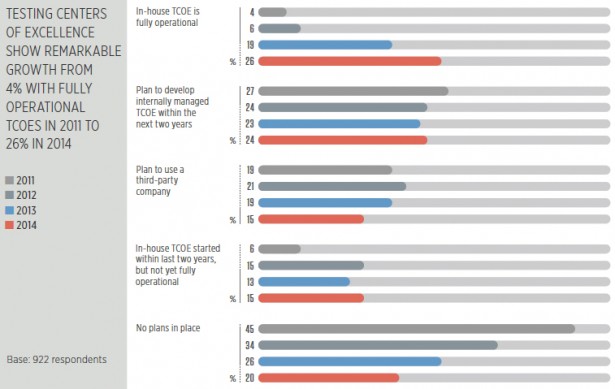10 Tips for Building a Testing Center of Excellence (TCOE)
The creation of a Testing Center of Excellence (TCoE) represents an organizational commitment to software quality. And as I’ve written recently, more IT organizations are adopting a TCoE model, according to the 2014-15 World Quality Report from HP, Capgemini and Sogeti (see chart below).

But for every organization investing in quality, there are plenty of others that:
- Rush to hit release dates with little regard for quality
- Allow numerous critical and severe defects into production
- Have a long backlog of known production issues
- Lack meaningful quality metrics and KPIs
If you’re a QA professional and you see some of your own organizational challenges in the list above, don’t despair. Transitioning to a TCoE is a journey. To start that journey, I've listed ten tips here that help create a culture of quality, in which a TCoE can grow and flourish. Some of my advice is simple, but not easy. Just like when someone tells you that eating less and exercising more are ways to lose weight.
Get executive buy-in
Commitment to quality has to come from the top of the organization. Executive support for quality is essential, and it has to be in actions not just words. If it is clear that a software release won’t be ready for production, key leaders must have the courage to do what is right for the business and speak up. This is just as true in Agile development environments.
Maintain independence
QA leaders need to be an independent voice for quality within their larger IT organizations and must be able to honestly deliver bad news without being handicapped by a conflict of interest. Recently, I visited a hospital system and the head of the PMO shared concerns about the risks of having the team configuring and implementing their EMR system also responsible for QA and testing activities. This situation can be like the fox watching the proverbial hen house.
Understand risk-reward trade-offs
Empowered QA organizations should have a seat at the table when there are discussions regarding business and technical risk-reward trade-offs. Promising zero defects and quality without compromise is often unrealistic in most fast-paced, competitive environments.
Focus on defect prevention and early detection
Early involvement of QA in the software development lifecycle consistently proves to save money in the long run. Defects caught in the requirements and design phases, can be hundreds of times less expensive then defects caught in production. In Agile environments, QA and Testing need to be part of the team every step of the way. The renowned architect Frank Lloyd Wright said “You can fix it now on the drafting board with an eraser or you can fix it later on the construction site with a sledge hammer.” Which do you think is cheaper?
Review integration challenges
Most testing teams do a pretty good job of functional testing in specific areas, like web- or retail- application testing. Customer experience defects are often found where the systems integrate. Therefore, it is important to have efforts dedicated to end-to-end integration.
Operationalize and automate repeatable tasks
At many companies, testing processes are manual and inefficient. It is important to operationalize and automate important, repeatable tasks to optimize your efforts. Automation is not just about regression testing; automation should be used for other tasks such as test data creation, test lab management tasks and reporting.
Standardize and simplify processes, tools and methods
Too many testing groups think their applications and workflows are unique and require customized processes, tools and methodologies. I have found that standardizing and simplifying testing processes, tools and methods has a profound and immediate return on investment.
Manage by facts
Standardizing allows leaders to manage by facts instead of emotions or opinions, enabling informed decision making. Having the facts available with a quality dashboard will assist line of business owners and executive management in decision-making and reinforce the value of the QA team to the organization.
Promote continuous improvement
It is important to continuously look for ways to improve the testing and QA process through lessons learned or root-caused analysis. Historical trends, such as release-over-release data are invaluable in developing estimation tools and release readiness predictive models.
Build a committed, high-performing QA team
QA teams are often a blend of employees, contractors and outside partners. Make sure all involved are fully-committed, high-performing and have the right attitude for success. It is amazing how much one person with a bad attitude can pull down a team. On the other hand, highly-skilled, motivated professionals that deliver results can lift up the people around them.
Ready to put your company on the road to positive quality transformation? Sign up for my free quality assurance assessment.
Mike Cooper is Chief Quality Officer and VP of Quality Assurance and Testing for Healthcare IT Leaders. He previously led QAT teams and initiatives at HP Software, T-Mobile USA and Equifax.
